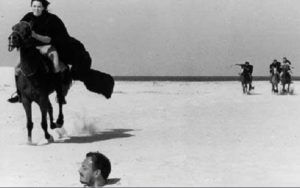HALLOWEEN CREEPTACULAR OCT 25: VIVA LA MUERTE (LONG LIVE DEATH) (1971)
 “Down with intelligence! Long live death!” — a fascist general in Viva La Muerte
“Down with intelligence! Long live death!” — a fascist general in Viva La Muerte
Filmmaker Fernando Arrabal’s troubled childhood haunts his first and most famous surrealist film, Viva La Muerte. The framework of the story of Fando (Mahdi Chaouch) whose father has been arrested for treason in Franco era Spain was based, in part, on true events.
Born on the cusp of the Spanish Civil War, Arrabal was just a child when his father, an officer in the Spanish Army, was sentenced to death for trying to assassinate the head of the Popular Front government. His punishment was later commuted to life-in-prison. When Fernando was nine, however, the elder Arrabal broke out of jail and was never heard from again.
The loss of his father informs much of Arrabal’s work, but none so much as Viva La Muerte, a movie called one of three “perfect surrealist films” along with Un Chien Andalou and El Topo by digitalbits.com.
The movie begins with some very strange yet striking opening credits. Superimposed over a childlike theme song sung by French schoolchildren Arrabal has layered Hieronymus Boschian etchings (by Fantastic Planet’s Roland Topor) of torture and sexual deviancy. It’s a grabber of an opening but the strange ride has just begun.
Episodic in nature, it’s a nightmarish coming of age story for Fando, who, despite his father’s execution for “political crimes” and his mother’s strange assertion that the father wasn’t executed, but actually committed suicide, clings to the belief that his father is alive and well. Fando soon realizes that his life is part of a web of lies when he learns that his mother was the one who turned his father into the authorities. In reaction to the mounting pressure from everyone in his life to renounce his Communist father, Fando conjures up a series of increasingly twisted Oedipal fantasies.
What follows is not for the weak of heart. These multi-colored scenes, seen decades after the film’s release, still have the power to cause shock and awe. Arrabal not only pushes the envelope, he tears it in half, showing disturbing and scatological scenes of Fando’s father being beheaded by his mother; his mother making love to his captors and later, the mother wearing a freshly slaughtered ox like a coat. I would say most certainly that Arrabal can’t guarantee that no animals were harmed during the production of this picture, and while he would never be able to get away with the butchery of the ox (or the beetle that is sliced in half or the decapitated lizard, for that matter) on film today, it is a vivid image.
Viva La Muerte’s jumble of surrealism and autobiography is a potent mix, made more effective by Arrabal’s unwavering use of disquieting imagery. Good taste is certainly not on the menu, but the dream sequences are unforgettable. In one scene Fando urinates over the side of a building while imagining that the entire town below is drowning in a sea of his urine. In another he imagines Arabesque men playing Polo with his father’s disembodied head. These are strange and unsettling images that take us further into the psyche of young Fando. He has been lied to, mistreated by those closest to him and in the end his only refuge is in the dark recesses of tortured mind.
Viva La Muerte is the very definition of “not for everyone.” It is risky and upsetting viewing, but in the avant-garde descriptions is a beautifully crafted — although completely gonzo — portrait of a young person in mental anguish.
